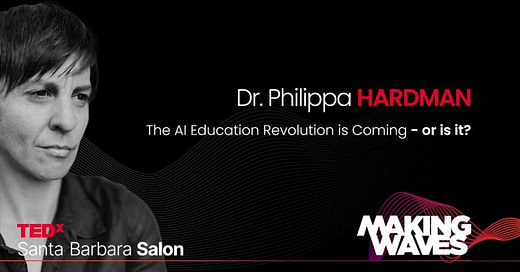Last night, I gave a TEDX Talk on AI and Education.
I decided to start the talk by taking the audience back to 1984 and the work of Educational Psychologist, Benjamin Bloom. At the time, Bloom was exploring a big education research question: what are the optimal conditions for human learning?
His findings were pretty exciting: Bloom and his team found that when a student is tutored one-to-one using coaching techniques which enable them to actively explore, co-create and apply knowledge, they performed two standard deviations better than students who were taught in a traditional, one-to-many “chalk and talk” classroom.
When we shift away from a “chalk and talk” approach and towards adaptive, personalised and active learning, 98% of students will achieve significantly better outcomes than those who are taught in a traditional, one-to-many classroom method.
30+ years of peer reviewed research later, and we have conclusively confirmed that when we shift away from a “chalk and talk” approach and towards more adaptive, personalised and active learning, 98% of students will achieve significantly better outcomes than those who are taught in a traditional classroom.
Bloom’s excited conclusion was that educators, innovators and governments should, "find new methods of scaling one-to-one mastery tutoring” to transform both the quality and the equity of education for all learners.
But his call to action fell on deaf ears.
Over the last 40 years, “innovative” education technologies like the overhead projector, the LMS, the interactive white board, powerpoint and the MOOC have been used to automate & accelerate “chalk and talk” style instruction.
So, are things changing with the rise of generative AI? The short answer is, a bit but not really.
AI: Revolution or Evolution?
Over the last six months or so, powered by Open AI’s release of ChatGPT, we’ve seen a continuation of a 40+ year-long trend. Every week more AI-powered education technologies come to market, but the vast majority accelerate, automate and scale traditional, broken methods of instruction.
There are, of course, exceptions to the rule and we are starting to see some ed-techs use AI to push use towards more effective instructional strategies:
Outside the classroom, Khan Academy recently released KhanMigo - an AI writing coach which delivers a personalised and adaptive dialogue based experience very similar to that described by Bloom and others as a more optimal experience for students.
Inside the classroom, AI coaching tools like Microsoft’s Reading Coach enable teachers to facilitate real-time adaptive and personalised 1:1 learning for their students.
What’s notable, however, is that tools like these are the exception rather than the rule. For every AI-powered piece of ed-tech that pushes us towards more effective instruction, there are ten examples which push is in the opposite direction, using AI to automate and scale ineffective “chalk and talk” practices.
As humans, we often automatically associate the rise of technology with innovation and change, but often this isn’t the case.
Take for example the introduction of Gutenberg's Printing Press in the fifteenth century.
We celebrate this as a momentous, historically significant and revolutionary technological innovation, but in practice for at least the first 200 years of its existence the printing press did more to spread & reinforce established ideas & behaviours and structures power than it did to disrupt them.
The story of AI in education so far is one of continuity rather than change, conservatism rather than disruption.
And in a similar way, the story of AI in education so far is one of continuity rather than change, conservatism rather than disruption.
So, when people ask me: Phil, will AI revolutionise education? My answer is always this: there is no question that AI could make education both more effective & more equitable. The bigger & more important question is, will we let it?
To use the Ford analogy: when it comes to AI and education, will we build faster horses, or will we leverage the power of AI to build cars which have real transformative and disruptive potential?
Want to learn more? You can check out the full talk here (33 mins).
Comments are open if you have any questions - I’d love to hear from you!
Happy innovating,
Phil 👋






Watch The Education Trinity 12-year-old video@ htpp://www.youtube.com/watch?v=PwVBxU385iM
I know why public school education has failed public school students since the time of Bloom's modified Carnegie Unit teaching model.
The resolutions are presented in the Educational Trinity Instructional Manual, 10 Immutable Laws of Education, The Vocabulary Loop---the foundation for all education, and the P1 P2 E D E Instructional Manual.
Mount your steed, with lance in hand and let us charge the windmill in the name of education, educationaltrinity@aol.com
John H. Ward, Executive Director of Educational Trinity a 501c3 nfp
I'd like to read the studies you refer to which say that the printing press had less of a disruptive impact than people think. The Wikipedia article you link to says this:
The arrival of mechanical movable type printing in Europe in the Renaissance introduced the era of mass communication, which permanently altered the structure of society. The relatively unrestricted circulation of information and (revolutionary) ideas transcended borders, captured the masses in the Reformation and threatened the power of political and religious authorities. The sharp increase in literacy broke the monopoly of the literate elite on education and learning and bolstered the emerging middle class. Across Europe, the increasing cultural self-awareness of its peoples led to the rise of proto-nationalism, and accelerated the development of European vernaculars, to the detriment of Latin's status as lingua franca.